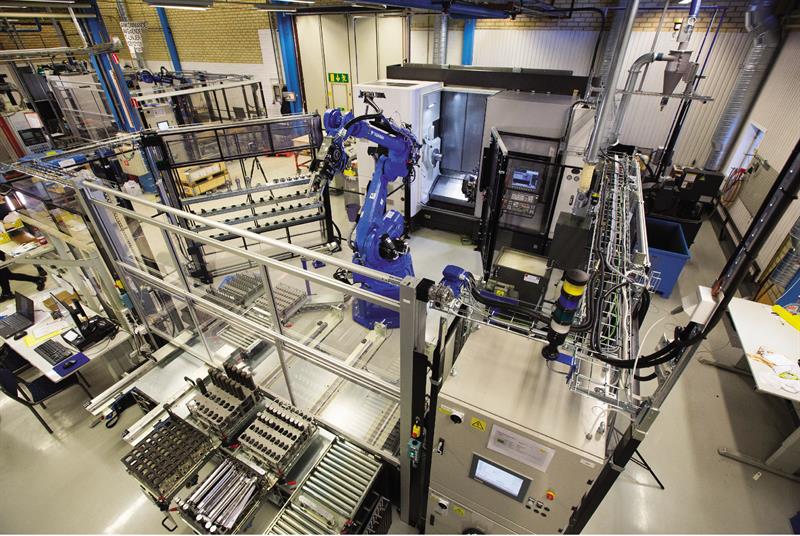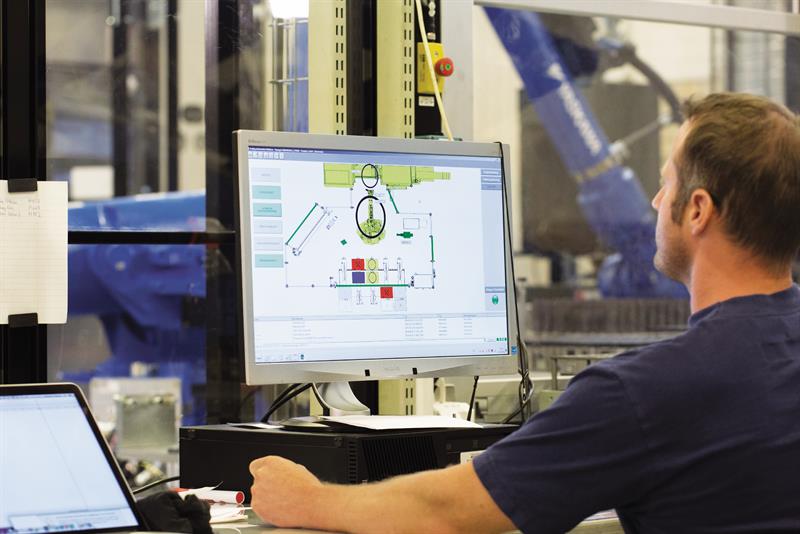Globally active maker of cutting tools Sandvik Coromant has partnered with machine tool supplier Okuma in pursuit of the creation of what it calls “the world’s best factory”. There, a ‘tailored’ Okuma Multus U3000 mill-turn machine (UK agent is NCMT, 0208 3984 2770) features, for the first time, robot loading of tooling to its lower turret.
The new machine (650 mm max turning diameter; 1,000 mm centre distance) has been installed at Sandvik Coromant’s facility in the Swedish town of Gimo, said to be the largest tool manufacturing operation in the world. The Gimo plant was set up in 1952 as a more modern industrial counterpart to Sandvik Coromant’s factory in Sandviken, also in Sweden. As a high income country, the Nordic country is a leader in the use of automation and Gimo has a 20-year track record in that.
INNOVATIVE CONCEPT REQUIRED
For a new automated boring bar production cell, the Gimo operation needed an innovative machining concept that would reduce toolchange time, keep manual intervention to a minimum and offer flexible production. The cell would be required to accommodate a range of over 700 boring bars, including both custom and standard designs, producing them in lot sizes of from one to 200 units.
In producing these tools, the installation needed to support shorter lead time production and, so as to keep finished product storage cost low, deliver on-demand manufacturing. As part of that, it had to offer minimised set-up time and eliminate manual tool changes. Joakim Fagerudd, production unit director tools, states Sandvik Coromant’s vision for the future: “We want to create the world’s best factory.”
According to Fagerudd, most standard CNC mill-turn machines did not allow for the required flexibility: “You can hardly find a machine tool with a toolchanger and a turret on the market.” But Okuma’s Multus U3000 met those requirements, having a single toolholder, -30 to +210° B-axis spindle unit fed by an ATC positioned above the horizontal spindle centre line and a turret below it, serviced by the new robot and external ATC solution.
But while the machine’s lower turret allows for drastically reduced tool-to-tool index time, Fagerudd was looking for a dependable solution. “It is no use having the fastest machines, when that means frequent breakdowns and, ultimately, no real time savings. This is why we aim for maximum reliability and stability,” he underlines.
Quality of output was also key. Says Johan Åsberg, change leader at Sandvik Coromant: “The quality of our tools directly affects the quality of the final products our customers produce. Okuma’s Multus U3000 enables the high surface quality that our products are known for."
A further Okuma credential is its global coverage, as he points out: “Our Gimo plant sets production standards worldwide. This is why we needed a global player. Okuma’s distribution network allows for support and availability of spare parts within 24 hours, which enables us to move this concept around the world.” And it was Okuma’s Swedish distribution partner, Stenbergs, that played a substantial role in realising the project. The company was involved in the early planning stages, oversaw the entire set-up of the cell in Gimo and provided training for operators.

The Okuma cell at Sandvik Coromant’s Gimo, Sweden, plant. It is the first time that automatic toolchanging into the machine’s lower turret has been employed by Okuma
Beginning in early 2016, the cell was installed in steps. Overall, it took 15 months from when the order was placed until the start of production. Fagerudd underlines this timescale as a major positive, saying: “No other machine supplier was able to work within the tight schedule and the financial framework that we approximated for the project.”
The solution delivered by Okuma not only involves a state-of-the-art multi-tasking machine but also includes a custom software solution that allows seamless dialogue between the machine, a Yaskawa robot (01295 272755) and Sandvik Coromant’s production planning system, TAP. The robot loads and unloads workpieces, changes machine collets and serves the machine’s lower turret and external ATC, expanding on the turret’s standard 12 positions by adding a further 40-plus locations for collets, centres and cutting tools held in the external toolchanger (the upper B-axis unit is served by an in-built ATC). This is the first time that Okuma has implemented robot tool loading to the lower turret, developing a hydraulic clamping mechanism in support of this capability.
Okuma developed and customised both software and hardware to deliver the high levels of automation demanded by Sandvik Coromant, while Japanese robotics manufacturer Yaskawa provided a testing ground at its Swedish facility, where the entire cell was set-up for preliminary testing.

Reliable communication between Sandvik Coromant’s TAP system (which is used in each of the company’s 150 automated cells around the world), the machine tool and the robot was critical in realising the solution. Integrating an external tool magazine proved to be a challenge, as Fagerudd explains: “We needed an open interface to be able to make the dialogue and signal flow seamless, and to allow for the flexibility that our production requires.”
Helpful in delivering the necessary integration, Okuma not only makes the machine but also the associated CNC unit. By eliminating a third-party provider, changes in programming can be performed as needed, with, in this case, Okuma’s custom tool management software enabling communication with the external magazine.
The TAP system generates data for the robot and the machine’s NC program, so that the cell ‘knows’ exactly which collet, centre and cutting tools are required for any job. Okuma developed a CNC-held library through which Sandvik Coromant accesses data via network connection from the Okuma controller, gaining access to tool, centre and collet information for use by TAP. NC programs for the machine and parameters for the robot are generated directly from a 3D model of the workpiece for each individual production batch.
The resulting connected multi-tasking cell supports 24/7 production. Every step of the process occurs automatically to eliminate manual intervention. The robot removes collets from the Multus U3000 and puts them on a rack. Okuma’s custom tool management software communicates to the robot exactly which collet to place in the multi-tasking machine for the upcoming operation. The entire process takes no more than a few seconds. The same goes for tailstock centre exchange (centres are held in the turret, too – picture, right).
Okuma’s tool management software tells the robot precisely which tool to supply to the machine’s lower turret, with Sandvik Coromant’s quick-change tool system Capto allowing for a large variety of tools for different operations to be employed. If a tool in the external tool magazine requires replacement, an extra control unit is employed to allow the new tool to be placed into the magazine; one of the rare occasions when an operator is required.
Machining takes two minutes per workpiece, on average, and requires three lower turret tool changes, with finished workpieces automatically palletised on cell-integrated stands by the robot.
CUSTOM DISPLAY SHOWS ALL’S WELL
Once production starts, an operator can tend to one of the many other production cells at the Gimo facility. A custom CNC interface gives access to machine tool errors, stops and collisions, with this information displayed on a colour-coded screen on the TAP system that reveals if the cell is working correctly (top left).
With the new installation, Sandvik Coromant has taken yet another step towards fully automated production. Says Fagerudd: “Working with Okuma has been incredibly collaborative and uncomplicated. The cell is running perfectly.”
As to future advances, Åsberg offers this: “You can always go leaner. Overall we are still looking to make our production even more efficient. Further automation will also remain a goal.”
The cost of the project is expected to be amortised within two years and this production solution will likely be used in other Sandvik Coromant factories around the globe, as Åsberg indicated earlier.
This article was published in the February 2017 issue of Machinery magazine.




